NVIDIA GeForce GTX 670 Review Feat. EVGA: Bringing GK104 Down To $400
by Ryan Smith on May 10, 2012 9:00 AM ESTSynthetics
We’ll also take a quick look at synthetic performance to see if NVIDIA’s choice of clockspeeds and disabling a SMX had any kind of other impact we haven’t anticipated. We’ll start with 3DMark Vantage’s Pixel Fill test.
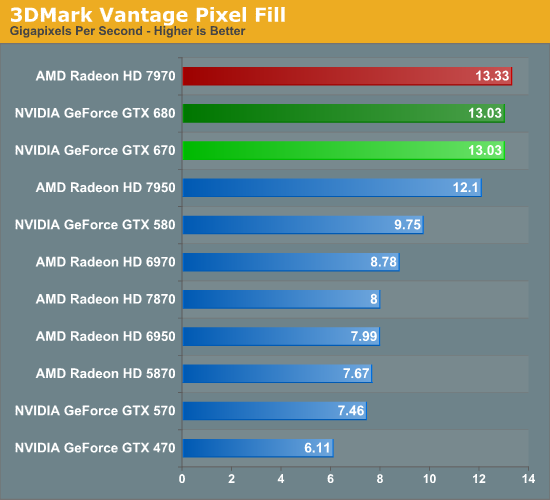
Pixel Fill is said to be memory bandwidth limited, and for good reason. Even with the lower clockspeed of the GTX 670, the fact that it has memory bandwidth equal to the GTX 680 means that it achieves equal performance in this test, confirming that GTX 670 can utilize its memory bandwidth just as well as GTX 680 can.
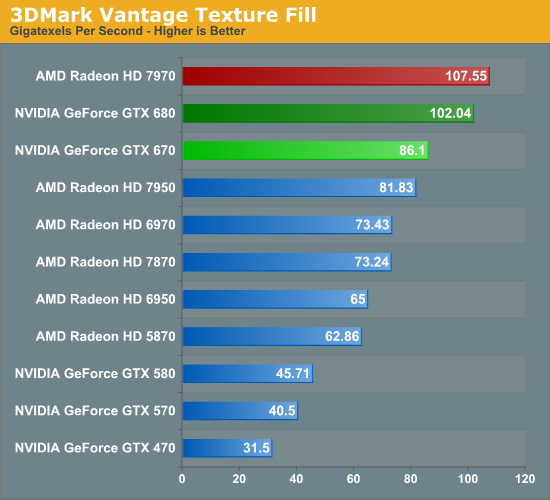
Our second test is 3DMark’s Texel Fill test, which as expected shows a moderate gap between the GTX 670 and GTX 680. Thanks to the loss of an SMX and the lower clocksped the GTX 670 only achieves 85% of the performance of the GTX 680, which thanks to the GTX 670’s more aggressive boost clock is a bit better than what we’d expect from the specifications.
Our third theoretical test is the set of settings we use with Microsoft’s Detail Tessellation sample program out of the DX11 SDK
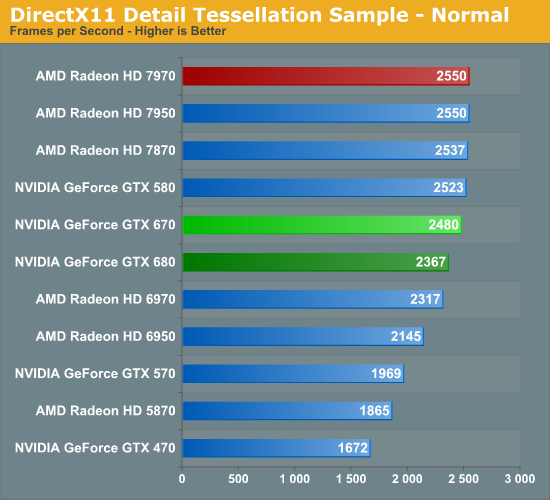
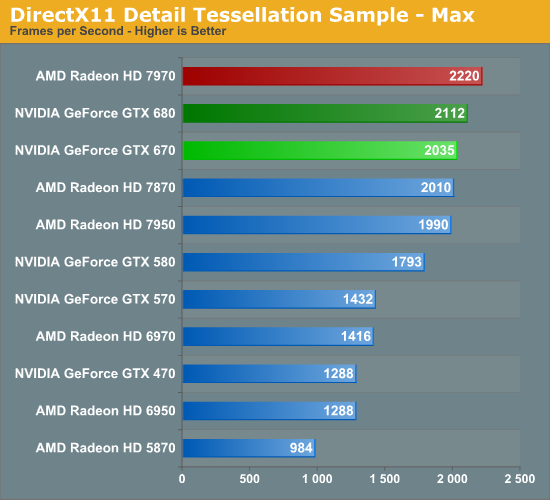
As expected GTX 670 falls behind GTX 680, but again not by nearly as much as we’d expect. The loss of the SMX means GTX 670 lost a Polymorph Engine, but with only a 4% gap with maximum tessellation you’d never be able to tell.
Our final theoretical test is Unigine Heaven 2.5, a benchmark that straddles the line between a synthetic benchmark and a real-world benchmark as the engine is licensed but no notable DX11 games have been produced using it yet.
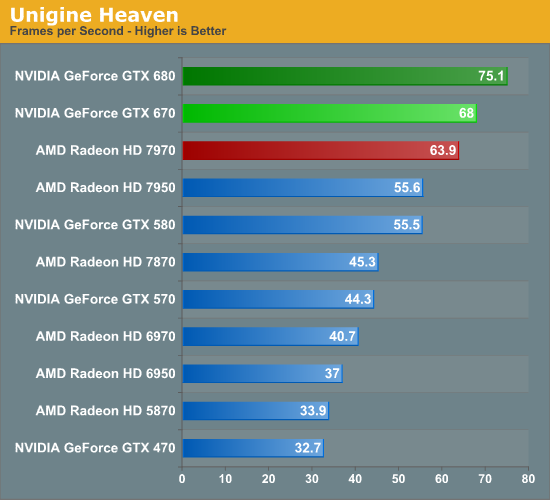
With Heaven the gap between the GTX 680 and GTX 670 once again opens up similarly to what we saw in our compute benchmarks with SmallLuxGPU. This means the GTX 670 falls behind by about 10%, reflecting the shader-heavy nature of this benchmark.










414 Comments
View All Comments
CeriseCogburn - Friday, May 11, 2012 - link
Here we are treated to 5 paragraphs of attack on the 600 series, note the extreme phrasing given against, the "known problem" of the GTX cards, not the "inexplicable" results that means something is wrong other than with the amd card when it loses.This contrasts with the bland put downs the 670 compared to the 680 and 570 receive when they win by enormous comparative margins in the rest of the game pages.
So the reviewer has a field day here:
" Overall performance isn’t particularly strong either. Given the price tag of the GTX 670 the most useful resolution is likely going to be 2560x1600, where the GTX 670 can’t even cross 30fps at our enthusiast settings."
Completely unmentioned of course after the jab at pricing just for the 670, same price as the 7950 that fares not playably better here and gets spanked the other 75% of time, is the 5760x1200 higher resolution where the 670 achieves even higher frame rates than 30, surpassing 30 all the way up to 35.6, just below 35.8 for the 7950, two tenths of one frame.
Somehow, that isn't mentioned, only the lower 2560 resolution with lower frame rates (for all the cards) but the 670 singled out as the only card that has peaked at "given the price".
Later in the review completely unplayable frame rates for all cards in a test is used to attack just the 570, too, for lack of memory. Forget the fact that none of the other cards had playable frame rates.
Eye candy was turned down at the triple monitor resolution but that has never before made 2560 most useful for reviews here, especially with lower frame rates for all the cards tested at the lower resolution settings. Only when we can cut down nVidia is such a statement useful, and it is very definitely confined to just the nVidia card then.
So avoided is the paltry frames of the other competing cards even at "easier" 5670 settings.
If the 670 is no good past 2560, then neither are any of the other cards at all, except the 7970 ? Maybe the reviewer suddenly has decided 5670 gaming is no good.
" Even 1920x1200 isn’t looking particularly good. This is without a doubt the legitimate lowpoint of the GTX 670. "
Well, then the 7950 doesn't look good at 1920 either, less than 1 fps difference, not to mention the 680 that is within in couple frames.
If we take the reviewers words with their total meaning, what we have is the unsaid statement that - only possibly the 7970 should be used for this game at 5670, no other card though.
Now - a total examination of the Crysis Warhead gaming page fps charts reveals this:
Every card is unplayable at every resolution except for the latest respective releases in 1920X1200 chart.
BrunoLogan - Friday, May 11, 2012 - link
... still unreachable for me on what budget is concerned. The 660Ti is what I'm looking for but as I saw somewhere it may be 5 or 6 months away and I don't know if I can wait that long. My old C2D need's replacement. I may just grab a 560Ti and later down the road get 760Ti skipping 6xx generation... bittersweet :-\
shin0bi272 - Friday, May 11, 2012 - link
what gpu do you have now? You said you need to upgrade your core 2 cpu but didnt say what you have for a gpu.Im still running a gts 250 and getting pretty good fps on everything but BF3 at pretty high specs on a 19x12 monitor. Your major issue with games today is they are made for consoles with dx9 cards in them that came out in 2006. So with some exceptions (crysis, metro 2033, and bf3 for example) you dont really need a huge card for anything other than playing all the new games at max spec. Sure everyone wants to do that but you dont necessarily NEED to. I played metro2033 and had physx on and it was easily playable in the 30-40 fps range.
So if you upgrade your cpu (which btw you really only need to upgrade to a quad core if its a gaming rig to get the max fps a cpu upgrade wil give you) and keep your current gpu and then when money allows grab a 670 or 685 or whatever AMD has to offer in your price range.
BrunoLogan - Friday, May 11, 2012 - link
Do you really want to know? I have a 9600GT :-P Also, I can't call it an upgrade as in "adding some new parts and keeping some of the existing ones". I'm really buying a new machine PSU and tower included. That's why I say it's bittersweet to buy a new machine with previous generation graphics.shin0bi272 - Monday, May 14, 2012 - link
hmmm well see what you have for cash left over after buying the important parts. Honestly buying a new system now is a good idea. Ivy bridge being released which drops the prices of sandy bridge (which as I said before will give you the same FPS in game) and even throwing $125 at a 550ti will be a good jump till the end of summer when the 685 comes out, and the 550 wouldnt give you the best fps so youd still be wanting to upgrade.shin0bi272 - Monday, May 14, 2012 - link
oh and a gts250 is a rebadged and die shrunk 8800gtxmedi01 - Saturday, May 12, 2012 - link
Hard to justify buying 560Ti, unless you somehow decided to only by nVidia.7850 consumes much less power while being ahead performance wise.
CeriseCogburn - Saturday, May 12, 2012 - link
7850 costs more, and has the massive disadvantage of being plagued with the now featureless in comparison amd crash pack latest, 12.4, to be followed on by another disaster within a months time.medi01 - Sunday, May 13, 2012 - link
Why don't you kill yourself, dear nVidia zealot with a lot of time to post utter nonsense?CeriseCogburn - Sunday, May 13, 2012 - link
LOL - hey man the facts aren't issues to be sad about.If I get depressed I'll let you know so you can help. :)